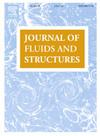Hydrodynamic interaction between 2D square cylinders in oscillatory, large-amplitude flow
IF 3.4
2区 工程技术
Q1 ENGINEERING, MECHANICAL
引用次数: 0
Abstract
We study hydrodynamic interaction effects on the in-line and cross-flow loads on two fixed, square, two-dimensional cylinders in infinite fluid subjected to oscillatory flow at high Keulegan–Carpenter () numbers (). The cylinder cross-sections are quadratic with both sharp and rounded corners. Both experiments and numerical simulations are carried out. The numerical simulations cover side-by-side, tandem and a range of staggered configurations. The experiments cover only tandem configurations, to which the CFD results agree well. The effect of rounding the corners and the two cylinders’ orientation relative to each other (facing each other, or facing the flow) are studied. The relative orientation is shown to matter significantly, while the rounding of the corners more moderately, although the loads are notably reduced. The drag, lift and inertia coefficients are presented and discussed in detail, and there is in general hydrodynamic interaction effects as expected and reported earlier in the literature. More notably, however, there are important load components due to hydrodynamic interaction, both in-line and cross-flow, but most pronounced in the cross-flow direction ( is the frequency of oscillation). The cross-flow loads are more sensitive to the cylinder orientation relative to the flow than the in-line loads.
振荡大振幅流动中二维方柱体间的水动力相互作用
我们研究了在高KC值(KC=5−24)的振荡流动条件下,流体动力相互作用对两个固定的方形二维圆柱体上的直列流和横流载荷的影响。圆柱体的横截面是二次的,有尖角和圆角。进行了实验和数值模拟。数值模拟涵盖并排,串联和一系列交错配置。实验只涵盖串联结构,CFD结果与之吻合较好。研究了圆角和两圆柱相对方向(相对于彼此或面向气流)的影响。相对方向被证明是重要的,而圆角更适度,虽然负载显着减少。阻力、升力和惯性系数被详细地提出和讨论,并且一般的流体动力相互作用效应如先前文献中所预期和报道的那样。然而,更值得注意的是,由于流体动力相互作用,有重要的2ω -负载分量,包括顺流和横流,但在横流方向上最明显(ω是振荡频率)。与直列负载相比,2ω的交叉流负载对相对于流量的气缸方向更为敏感。
本文章由计算机程序翻译,如有差异,请以英文原文为准。
求助全文
约1分钟内获得全文
求助全文
来源期刊

Journal of Fluids and Structures
工程技术-工程:机械
CiteScore
6.90
自引率
8.30%
发文量
173
审稿时长
65 days
期刊介绍:
The Journal of Fluids and Structures serves as a focal point and a forum for the exchange of ideas, for the many kinds of specialists and practitioners concerned with fluid–structure interactions and the dynamics of systems related thereto, in any field. One of its aims is to foster the cross–fertilization of ideas, methods and techniques in the various disciplines involved.
The journal publishes papers that present original and significant contributions on all aspects of the mechanical interactions between fluids and solids, regardless of scale.
 求助内容:
求助内容: 应助结果提醒方式:
应助结果提醒方式:


